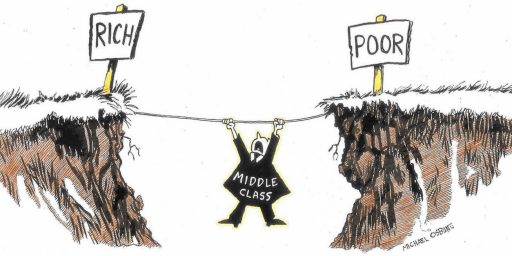CLASS CUTOFFS
Kevin Drum is trying to get working definitions of the various social class labels and proposes the following as a conversation-starter:
Poor: $0-$15,000 Working poor: $15,000 – $25,000 Lower middle class: $25,000 – $35,000 Middle class: $35,000 – $65,000 Upper middle class: $65,000 – $90,000 Well off: $90,000 – $150,000 Very well off: $150,000 – $350,000 Rich: $350,000+
He realizes this is oversimplified, noting,
Obviously this doesn’t take into account size of family, region, type of income, etc. etc. Nor are these technical definitions. I’m just looking for the most general kind of consensus about what’s in people’s heads when these words are used.
Indeed, region is enough all by itself to blow these out of the water. By this table, I’m in the upper middle class (just barely). But that’s solely a function of my now living in the DC Metro area. My standard of living, in terms of material wealth, notably the ability to buy a single family home, is less now than when I was at the lower end of Kevin’s “middle class” scale but living in rural Alabama a little over a year ago (although improved in almost all other aspects). $100,000 a year would be “very well off” in Alabama but only “upper middle class” here–and probably barely “middle class” in Manhattan or Monterey.
It is interesting how little this regional variation is considered when we make public policy. The federal government understands this as a basic concept, as it provides regional cost of living adjustments for military and civil service personnel. (The determination of this is highly controversial, too, but that’s a different debate.) It makes no sense in terms of the income tax system, for example, if the idea of a progressive tax structure is to take more from those who can afford more. (This is offset somewhat for those who can afford to buy homes, since housing prices are the main variable.)
My sense of things is that most people in middle America think people living in Manhattan are rich and most people living in the major metropolitan areas think people earning $60,000 out in the hustings are illiterate failures. I could never persuade my students, for example, that a Congressman making $150,000 a year was grossly underpaid, especially considering he had to keep a place near the office as well as a residence back home.
“Civil Rights Lawyer” has a more plausible scale that he submits in Kevin’s comments section:
Rich: Could stop working now and still send kids to college and live a nice life-style with a nice house, nice car, nice vacations, etc. So far out of qualifying for need-based college financial aid for kids that don’t even bother applying. Your idea of financial disaster is Bolsheviks taking over.
Very Well Off: Could stop working at a very-early retirement age (50-55) and still send kids to college and live a nice life-style with a nice house, nice car, nice vacations, etc. Apply for need-based college financial aid for kids but don’t really think that you’ll be given any. Your idea of financial disaster is a prolonged bear market.
Upper Middle Class: Could stop working at a normal retirement age (65) and still send kids to college and live a nice life-style with a nice house, nice car, nice vacations, etc. Apply for need-based college financial aid for kids and surprised to learn that you don’t qualify because your income’s too high. Your idea of financial disaster is being unemployed for six months.
Middle Class: Can retire at age 65, but need to cut back on travel, etc. Receive need-based college financial aid for kids, but not as much as you thought you’d get. Your idea of financial disaster is being unemployed for two months.
Lower Middle Class: Can’t retire until age 70 and can’t travel when retired except to visit family, etc. Receive good need-based college financial-aid package for kids. Your idea of financial disaster is being fired.
Working poor: Retirement would be financially difficult — social-security income during retirement is really crucial. Receive very generous need-based college financial-aid package for kids. Your idea of financial disaster is utility rates being raised and food prices going up.
Poor: What’s retirement? If social-security goes under, you’re dead. Even with super generous need-based financial-aid, can’t send kids to college. Your idea of financial disaster is your current life.
That sounds about right.





